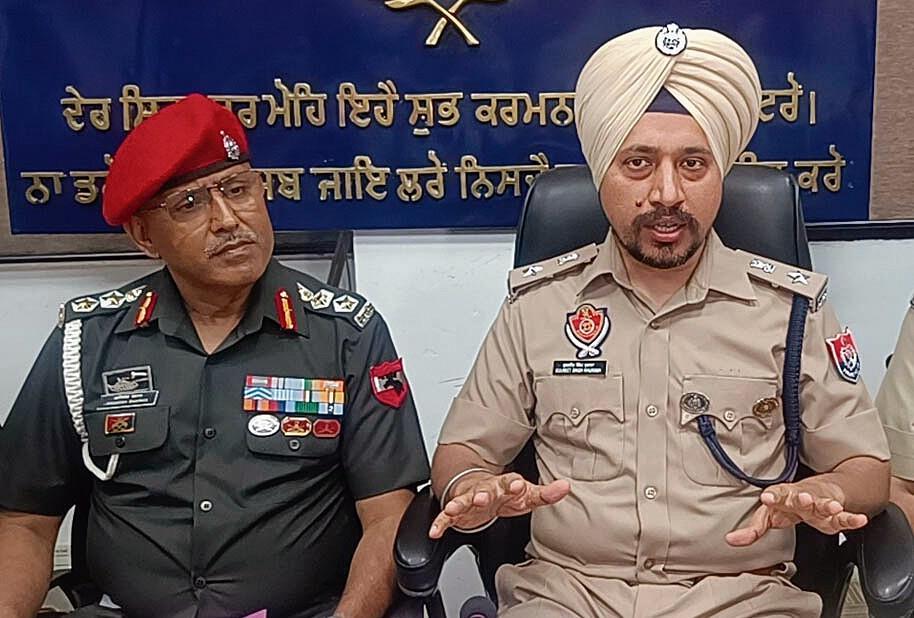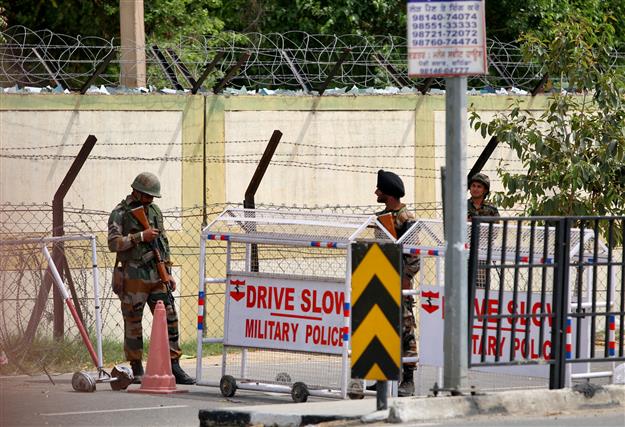








Chandigarh, April 18
Resuming organ transplant procedures after nearly a decade, the Western Command Hospital, Chandimandir, harvested three organs from a brain dead person and transported these to Delhi, giving a fresh lease of life to three serving soldiers with terminal illness.
The multi-organ retrieval of liver, two kidneys and corneas was undertaken in a marathon nightlong operation and immediately airlifted to the Army Research and Referral Hospital, New Delhi, by an Indian Air Force aircraft via a green corridor.
A serving soldier’s 63-year-old father, who was a cardiac patient, had suffered a fatal brainstem stroke while admitted to the intensive care unit of the Command Hospital. The soldier consented to donate the organs of his deceased father for the welfare of terminally ill and ailing soldiers with end-stage liver and kidney diseases.
The hospital’s organ transplant team, led by Brigadier Anuj Sharma, consultant in surgical gastroenterology and transplant surgery, was galvanised in the middle of the night and performed the complex procedure with the support of the critical care intensivist and chief of transplant.
The recipients of liver and kidney are said to be doing well and on the road to recovery.
Organ donation was started in the armed forces in the late 2000s and introduced in the Western Command Hospital in 2014. The process is coordinated by the Armed Forces Organ Retrieval and Transplantation Authority in New Delhi. — TNS
Nightlong operation

he prolonged standoff in eastern Ladakh and China’s provocative moves in Arunachal Pradesh have made it incumbent upon the Indian armed forces to perpetually remain in a state of operational preparedness along the Line of Actual Control (LAC). Towards this end, the Army and the Air Force carried out a multi-domain exercise in strategically key areas in the eastern sector last week. The exercise showcased the synergy between strategic forces and troops of the Eastern Command for undertaking joint operations in high-altitude and mountainous terrain. C-17 Globemaster aircraft, Chinooks and Mi-17 choppers undertook multi-mode insertion operations into designated greenfield landing zones. The focus was on speed, precision and lethality of deployment of specialised troops in a hostile environment.
The latest drills were conducted weeks after Vayu Prahar, a 96-hour multi-domain air-land exercise. The latter had involved the insertion and extraction of the Army’s Special Forces at a designated Advanced Landing Ground by C-130J Super Hercules and C-17 Globemasters of the IAF. Vayu Prahar was aimed at improving coordination among various agencies for rapid mobilisation, transportation and deployment of forces. Such exercises, executed by specially designated, trained and equipped units, demonstrate the defence forces’ battle readiness. The message to China is loud and clear: India is well prepared for any misadventure or provocation from across the LAC.
New Delhi’s proactive approach has also been highlighted by External Affairs Minister S Jaishankar, who said in Uganda earlier this week that people were now witnessing a ‘different’ India that no longer took things lying down. Referring to Uri and Balakot, he asserted that the country was capable of meeting its national security challenges. This makes it imperative for India to enhance defence cooperation with friendly nations. Dharma Guardian, an annual exercise involving Indian and Japanese forces, is an important initiative. So too are the bilateral military drills with other Quad countries (the US and Australia) and multilateral exercises such as the one scheduled to start in France next week. The sharing of best practices in tactics, techniques and procedures of conducting tactical operations are bound to put India on a stronger footing to confront China as well as Pakistan.

Sukhmeet Bhasin & Ajay Banerjee
Tribune News Service
Bathinda/New Delhi, April 18
Arrested Army jawan Gunner Desai Mohan, during his interrogation by the Punjab Police, had claimed that he shot dead four of his colleagues at the Bathinda military station on April 12 to avenge alleged sodomy.
Edit: Another fratricidal act
The Bathinda Cantonment police, meanwhile, have added Section 380, IPC, to the FIR for stealing an INSAS automatic rifle that was allegedly used for the killings. The previous sections were IPC 302 (murder) and 25 of the Arms Act.
In New Delhi, Army authorities said the Gunner’s medical examination to ascertain “sexual assault” and the forensic test of the rifle to check the fingerprints were being handled by the Punjab Police.
Following his “confession”, the police arrested Desai yesterday and he was produced in court, which remanded him in police custody till April 20. The matter would be tried in a civilian court, sources said. The aspects of “sodomy” and rifle theft are likely to reflect in the chargesheet.
The Army’s court of inquiry (CoI) that was ordered earlier too shall continue. The CoI may apportion blame on officers who should have been in the know if the accused was facing any physical abuse and if he had shared his ordeal, was any action taken. Though Desai has “admitted to” stealing the rifle, the CoI will also seek to probe dereliction of duty at the armoury.
The rifle and 28 rounds were stolen on April 9. After allegedly committing the crime on April 12, the accused wrapped the rifle in a cloth and plastic pouch and hid it in a sewer pit. The four jawans were killed at 4.30 am in barrack rooms near the Officers Mess. After five days (on April 17), the Bathinda police and the Army, at a joint press conference, announced the breakthrough and Desai’s arrest.
The delay behind cracking the case was mainly due to two reasons. The Army was working on Desai’s statement who had claimed he was the sole eyewitness and saw two men fleeing after the killings. The Bathinda police were preoccupied with the Baisakshi fair at Talwandi Sabo, which concluded on April 15.
Sec 380 added
Section 380 has been added to the FIR for stealing the INSAS automatic rifle that was allegedly used for the killings


Washington, April 18
A leaked US military assessment says the Chinese military may soon deploy a high-altitude spy drone that travels at least three times the speed of sound, the Washington Post reported late on Tuesday.
The newspaper cited a secret document from the National Geospatial-Intelligence Agency.
The document, which Reuters could not confirm or verify independently, features satellite imagery dated Aug 9 that shows two WZ-8 rocket-propelled reconnaissance drones at an air base in eastern China, about 350 miles (560km) inland from Shanghai, according to the newspaper.
The US assessment said China’s People’s Liberation Army (PLA) had “almost certainly” established its first unmanned aerial vehicle unit at the base, which falls under the Eastern Theater Command, the branch of the Chinese military responsible for enforcing Chinese sovereignty claims over Taiwan, the newspaper reported.
The US Defense Department did not immediately respond to a request for comment. The Chinese government could not immediately be reached for comment.
The Washington Post said it obtained the assessment of the program from a trove of images of classified files posted on the Discord messaging app, allegedly by a member of the Massachusetts Air National Guard, who was arrested last week.
The FBI on Thursday arrested Jack Douglas Teixeira, a 21-year-old member of the US Air National Guard, over the leaks online of classified documents that embarrassed Washington with allies around the world.
The leaks first became widely known earlier this month, setting Washington on edge about the damage they may have caused. The episode embarrassed the US by revealing its spying on allies and purported Ukrainian military vulnerabilities.
Taiwan president Tsai Ing-wen’s recent meeting with US House of Representative Kevin McCarthy had upset Beijing. China, which claims democratically ruled Taiwan is one of its provinces, says Taiwan is the single most important and sensitive issue in its relations with the United States.
Taiwan’s government rejects Beijing’s sovereignty claims. Reuters
The 2019 Pulwama attack, in which 40 CRPF men were killed, is set to return to haunt the Modi government, with the Congress working to make it a rallying point for Opposition parties. Former J&K Governor Satyapal Malik’s allegation that the Centre’s reluctance to airlift CRPF personnel gave an opportunity to terrorists to strike has created a flutter in the political circles.
‘Govt must answer’
The Congress says the government should provide answers to questions such as what were the “intelligence failures” in the Pulwama attack and why the CRPF troops were denied aircraft.
The Congress on Tuesday said the government should come out with a white paper on the Pulwama attack, answering what were the “intelligence failures” and why troops were denied aircraft.Powered
Congress spokesperson Shaktisinh Gohil said the party did not make any political statement over an incident like Pulwama in 2019, but had to raise this issue as concerns have been expressed by former Army Chief Gen Shankar Roychowdhury (retd) in an interview. The Congress held a press conference here by Col Rohit Chaudhry (retd) and Wing Commander Anuma Acharya (retd), both associated with the party.
“General Roychowdhury says the primary responsibility behind the loss of lives in Pulwama rests on the government. What responsibilities have been fixed for Doval, then Home Minister Rajnath Singh and PM?” Col Chaudhry and Wing Commander Acharya asked.

The Bathinda case brings to the fore a serious lapse in ensuring zero tolerance of sexual offences in an army unit. This important military establishment on the western frontier couldn’t ensure an effective grievance-redressal mechanism that would have punished the predators instead of forcing the gunner to commit multiple murders. – File photo
https://cdn.vuukle.com/widgets/audio.html?version=1.0.5
Advertisement
The Bathinda case brings to the fore a serious lapse in ensuring zero tolerance of sexual offences in an army unit. This important military establishment on the western frontier couldn’t ensure an effective grievance-redressal mechanism that would have punished the predators instead of forcing the gunner to commit multiple murders. The army should review its internal systems to ensure a harassment-free life in uniform. It must carefully address this issue rather than sweep it under the carpet. The army practises zero tolerance to fratricide. For instance, upholding life imprisonment and dismissal from service awarded by a court martial to a jawan for shooting dead his guard commander and attempting suicide, the Armed Forces Tribunal last November ruled that such cases should be dealt with strictly to maintain discipline. However, it must also go into the reasons why some soldiers are driven to these extreme acts and take remedial measures to mitigate the aggravating circumstances.
With a gunner having been established as the main accused in the killing of four fellow jawans in the Bathinda military station on April 12, the issue of the alarming prevalence of fratricide in the security forces, including the Central Armed Police Forces (CAPF), has again cropped up. It reinforces the need to acknowledge fratricide as a job hazard of the forces and step up its act on containing it. Last July, two personnel became the target of a fratricidal attack at an army camp in Surankote of Poonch district. Around 18 acts of fratricide reportedly took place in the Army and two in the Air Force between 2014 and March 2021. The situation is worse in the CAPF, with 29 paramilitary troopers having been killed by their colleagues in the 2018-22 period. They include the four BSF jawans shot dead by a fellow jawan in Amritsar district in March 2022.
Underlying these grim figures are the tough working conditions of the security forces that lead to mental stress, as also the availability of weapons. The government needs to assess why the remedial measures taken over the years have not made much difference on the ground.

The road crossing at Government Press in Sector 17, Chandigarh, which is being transformed into an Air Force museum, has a Gnat plane placed atop a pillar with the title ‘Sabre Slayer’. The diminutive Folland Gnat got the moniker when it bettered the American Sabre fighter jets in the 1965 War with Pakistan. Leading the Air Force as the Chief of the Air Staff was Arjan Singh (1919-2017), a recipient of the Distinguished Flying Cross (DFC).
Unlike the earlier engagement with China, the IAF was authorised by the then Defence Minister YB Chavan on the very first day of the war to engage the enemy. Years later, Arjan Singh would recall: ‘We were able to attack Pakistani troops. We lost four Vampire aircraft, but the attack was a major achievement. Though planning and execution could have been better, the objective of stopping Pakistan’s advance was achieved.’
This was the beginning; the war escalated, and the Indian Army and the Air Force performed well, as can be judged from some of the headlines in the newspapers during the period as well as from Chavan’s diary: ‘Debacle to Revival: YB Chavan as Defence Minister 1962-65’ by RD Pradhan, the minister’s aide.
On September 9, 1965, Chavan told Parliament: ‘The House is undoubtedly proud of the performance of our boys in the Air Force who have destroyed several Pakistani Sabre jets.’ Three days later, he wrote: ‘CAS (Chief of the Air Staff) is given OK for Peshawar. When he is asked to go ahead on a new task, CAS walks as a dancing bird. A real fighting Sikh, and yet how soft and gentle.’ Ten days later, he was to say: ‘Army and Air Force have become now for us the symbols of our national pride and glory. A great day for me. A great day for Chaudhry (the Army Chief) and Arjan Singh… Air Marshal Arjan Singh is a jewel of a person; quietly efficient and firm, unexcitable but a very able leader.’
During the war, the IAF penetrated deep into Pakistani territory and attacked Peshawar, Quetta, Rawalpindi, Sargodha and other cities. It was a short war, stopped mainly because of international pressure as India was winning. Both the Army and Air Chiefs were awarded the Padma Vibhushan, and Arjan Singh’s rank was raised to that of Air Chief Marshal.
A leader who led from the front, he would, in 2002, become IAF’s first and only Field Marshal, an exemplar for the force and the people at large. The nation showered honours on him. He too gave it his all, including selling off his farm to create a fund for the welfare of Air Force servicemen. As we mark his birth anniversary today, we salute our only Marshal of the Indian Air Force, Arjan Singh, DFC.

Chandigarh, April 17
As many as 120 commandos from various police forces were imparted training in heli-slithering at the Indo-Tibetan Border Police Force’s (ITBP) Basic Training Centre in Bhanu, Panchkula.
The commandos included 19 women from different units of the ITBP. The trainees included personnel from the Central Bureau of Investigation and the Bureau of Police Research and Development.
Heli-slithering is a means of descending from a hovering helicopter with the help of a rope and enables rapid induction of troops in remote areas, difficult terrain or built up areas where helipads are not available.






















































